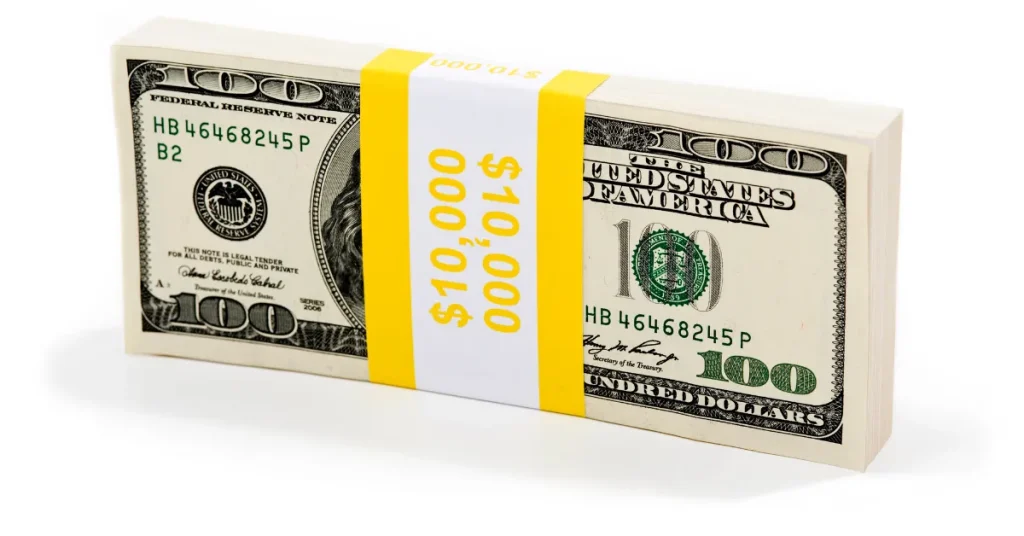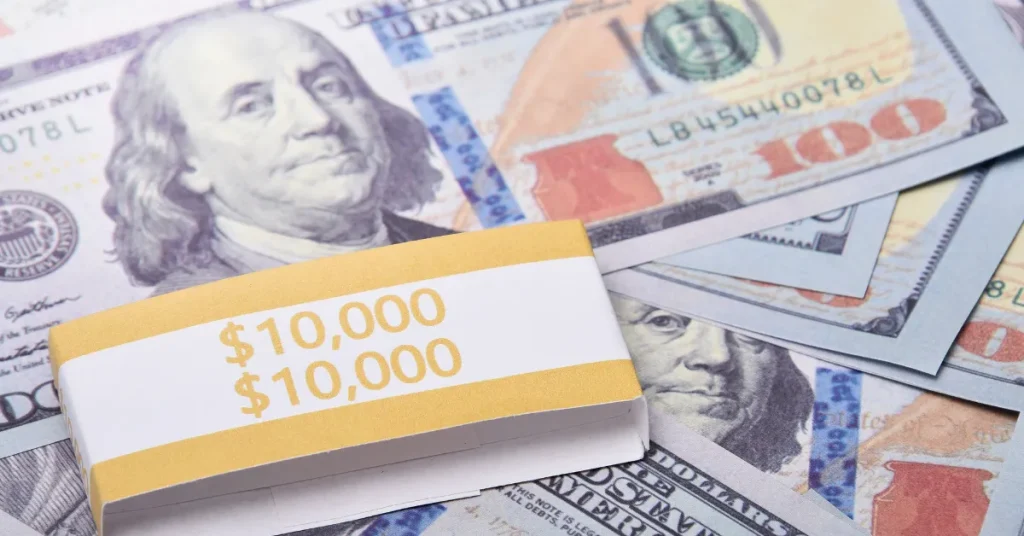A $10,000 stack of $100 bills is about half an inch thick. This stack comprises 100 individual $100 bills bound together.
Knowing the physical dimensions of currency is surprisingly useful, whether you’re planning a cash transaction, preparing for a bank deposit, or simply satisfying your curiosity about money.
Currency dimensions can serve practical purposes, such as fitting cash into envelopes, safes, or wallets, and can also be a point of interest for those who handle significant sums of money.
The U. S. $100 bill, with its notable security features and distinctive design, is a common denomination for large transactions. A neat stack of these could easily be tucked into a briefcase or deposit bag.
For many dealing in cash, the thickness of a money stack is just as important as its total value. Understanding such specifics about cash not only assists in planning and organizing but also exemplifies the tangibility of wealth in a physically measurable form.

Introducing The $10,000 Question
Imagine holding $10,000 in your hands. How thick would that stack be? It’s a question that tickles our love for interesting trivia. Let’s dive in and visualize a $10,000 stack of $100 bills.
We’ll explore how such an amount feels to the touch and the illusions it can create about size and wealth.
Counting The Cash: Visually Representing Wealth
Visualizing a pile of cash can be exciting. It symbolizes success and purchasing power. But what does $10,000 in $100 bills look like? Let’s break it down:
- $100 bills are just 0.0043 inches thick.
- 100 of these make up $10,000.
- Stack them up, and you have a pile just 0.43 inches tall.
To give a clearer picture, that’s just about the thickness of a standard pencil or a smartphone lying on its side!
The Feel Of Fortune: Textures And Size Perceptions
Touch can deceive us when it comes to money. A stack of $10,000 may feel smaller than expected. Its surprising modesty in size can make it a mix of excitement and wonderment. Consider these points:
| Texture | Size | Perception |
| Crisp $100 bills | Compact stack | Feels luxurious yet small |
| Smooth edges | 0.43 inches high | Underestimates real value |
Those new to handling cash might expect a larger pile. Yet, currency efficiency gives us a neat and tidy sum.
Money Measurements: Key Dimensions Of Currency

Understanding the dimensions of currency is essential. Bills and coins come in specific sizes and thicknesses. These standards help to maintain consistency.
When we talk about a stack of $100 bills totaling $10,000, size matters. Let’s explore how currency measurements play a role.
Standard Sizing: The Uniformity Of Currency
Currency size standardization is key. It allows for easy handling and storage. In the United States, a $100 bill measures 6.14 inches long, 2.61 inches wide, and 0.0043 inches thick. Regardless of the denomination, all bills share these dimensions:
- Length: 6.14 inches
- Width: 2.61 inches
- Thickness: 0.0043 inches
This uniformity simplifies tasks like using ATMs and counting machines. Bill validators in vending machines also rely on these standards. Keeping a consistent size helps prevent counterfeiting. It ensures machines can detect fake bills.
Thickness Tales: Materials And Minting Processes
The thickness of banknotes comes from the materials and minting processes. Each bill comprises a blend of cotton and linen. This blend gives durability and a slight texture. Special inks and security features also add minute thickness.
Even with durability in mind, a bill’s lifespan is only about 7.5 years. During this period, a bill can become thicker due to dirt, oils, and moisture.
A stack of 100 $100 bills equals $10,000. Here’s a quick breakdown of its estimated thickness:
| Number of $100 Bills | Thickness | Total Height |
| 100 | 0.0043 inches (per bill) | 0.43 inches |
Thus, a $10,000 stack of $100 bills totals 0.43 inches in thickness. However, factors such as wear and handling may slightly alter this dimension.
Crunching The Numbers: Calculating The Stack
Ever wondered about the physical dimensions of money? Let’s dive into the fascinating world of currency and explore just how thick a $10,000 stack of $100 bills is.
With some basic calculations, we can visualize our cash in a whole new way. Time to crunch the numbers and uncover the secrets of a bank stack!
Single Bill Specifics: Analyzing The Thinness Of $100
The U.S. Bureau of Engraving and Printing states that a $100 bill is 0.0043 inches thick. To understand how a stack of these bills adds up, let’s examine a single note’s dimensions.
- Length: 6.14 inches
- Width: 2.61 inches
- Thickness: 0.0043 inches
Mathematical Multiplication: Stacking Up To $10,000
Reaching that $10,000 mark requires a stack of 100 individual $100 bills. Simple multiplication lets us visualize the total thickness.
| Number of Bills | Thickness per Bill (inches) | Total Thickness (inches) |
| 100 | 0.0043 | 0.43 |
So, the stack is 0.43 inches thick. That’s less than half an inch! Imagine holding ten grand in one hand; it’s quite compact.
Physical Factors Affecting Stack Size
When you picture $10,000 in $100 bills, the thickness of that stack may seem straightforward. Yet, various physical factors can alter its size substantially.
Wear And Tear: How Usage Changes Currency Dimensions
Money circulates; it gets passed from hand to hand. This journey isn’t gentle and leaves marks on each bill. New bills are crisp and uniform, but over time, they develop:
- Folds and creases
- Tears and repairs
- Wrinkles and bulges
These imperfections increase the space a stack requires. Bills that have been heavily used could make a $10,000 stack noticeably thicker than a stack of fresh bills.
Packing Pressure: The Role Of Force In Compacting Bills
Imagine a vice pressing against a stack of bills. The force applied can compress the bills remarkably, changing their thickness. The factors include:
| Condition | Effect on Bill Thickness |
| Loose Packing | Bills retain more air, remain thicker |
| Tight Packing | Bills compress, stack becomes thinner |
In real life, bills aren’t under constant pressure, but how they are stored can influence their size. A stack wrapped tightly in a band could be thinner than one left loose in a bag.
Real-life References: Visualizing $10,000
Picture this: a stack of $100 bills worth $10,000. You might think it’s huge. But how thick is it really? It’s quite surprising!
Everyday Equivalents: Comparing To Common Items
Let’s find out how big this money pile is by comparing it to things you know:
- A stack of $10,000 in $100 bills is only about 0.43 inches thick.
- That’s like stacking four standard chewing gum sticks on top of each other.
- Or it’s as tall as a standard smartphone lying face up.
This shows that a lot of value can fit in a small space!
Volumetric Visuals: Employing 3d Models And Depictions
Seeing in 3D can help us grasp the size better. Here’s how you can visualize it:
- Imagine a small model car. This is much bigger than our $10,000 stack.
- Next, picture a tiny LEGO brick. Our money stack is a bit taller.
- Finally, think of a box of paper clips. If you laid them out, they would cover more space than the stack of cash.
Using these models, the stack’s size becomes much easier to picture.
Beyond The Stack: The Value Of $10,000

Curiosity often piques when visualizing a $10,000 stack of $100 bills. But the real intrigue lies not in its thickness but its potential.
Join us as we delve into the purchasing power of $10,000 and explore how inflation impacts its value.
Purchasing Power: What Does $10,000 Buy You Today?
A crisp stack of $10,000 might seem hefty, but what does it truly afford you in this day and age?
Think of it as a key that unlocks various opportunities and needs.
- Home Down-payment: It could serve as the starting point for buying a new home.
- Education: It might cover a significant portion of tuition fees for higher studies.
- Travel: Fund a dream vacation or two, exploring new cultures and cuisines.
- Emergency Fund: Provide a safety net for unplanned events or healthcare needs.
- Investments: Act as a seed investment in stocks, bonds, or a small business.
Historical Worth: Inflation And The Evolving Value Of Money
$10,000 wasn’t always worth the same.
Over time, money’s buying power changes.
| Year | Value Equivalent Today |
| 1990 | $20,000 |
| 2000 | $15,000 |
| 2010 | $12,000 |
| 2020 | Approx $10,000 |
Inflation can erode money’s value.
What you could buy for $10,000 in the past is not the same as today.
FAQs About How Thick Is A $10 000 Stack Of $100 Bills
How Thick Is A 10k Stack?
A 10k stack of $100 bills is about 0. 43 inches or 1. 1 centimeters thick, assuming crisp, new bills.
How Thick Is A $1000000 Stack Of $100 Bills?
A $1,000,000 stack of $100 bills is about 43 inches tall.
What Are The Dimensions Of A Stack Of 100 Dollar Bills?
A stack of 100 one-dollar bills measures 0. 43 inches in thickness, 6. 14 inches in length, and 2. 61 inches in width.
How Many Inches Thick Is A 100 Dollar Bill?
A 100 dollar bill is approximately 0. 0043 inches thick.
Conclusion
Wrapping up our exploration, we now know a $10,000 bundle of $100 bills isn’t just about wealth—it’s a measurable stack.
This nugget of knowledge merges finance with fun facts, enriching cocktail conversations and trivia nights alike. Remember, the thickness of cash can tell an interesting story by itself!
Resources:
1. https://www.uscurrency.gov/denominations/100
